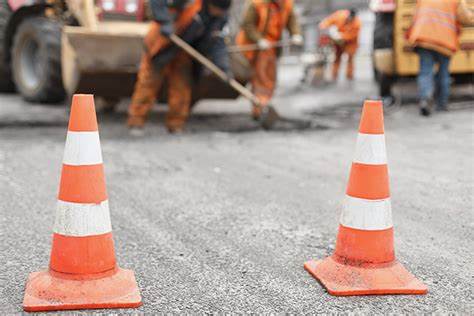According to the Federal Department of Transportation (DOT) a work zone is an area of a highway with construction, maintenance, or utility work activities. Work zones are typically marked by signs, channelizing devices, barriers, pavement markings, and/or work vehicles. Highway, road, street, bridge, tunnel, utility, and other workers for the highway infrastructure are exposed to hazards from outside as well as from inside the work zone.
You need to raise awareness of Work Zone Safety with your employees. We encourage you to have Safety Meetings or Toolbox Talks with your crews. For crews that are working on projects in work zones, a daily safety meeting at the start of every shift is recommended. If that is not feasible, then weekly safety meetings with every crew member on the project should be held.
In addition to covering other hazards that are specific to the project and the job site, the points listed below for work zone safety should be emphasized at every safety meeting:
- Workers need to be visible to any potential traffic and heavy equipment.
- Safety vests should be worn with hard hats to help the worker stand out and be visible to traffic.
- Work zones need to be clearly identified both for the safety of the workers and for the public.
- Federal and State standards regulate the type of signs, barricades, barriers, or channeling devices that can be used.
- Posted speed, type of work and time of day are all factors that workers should know when required to establish work zones.
- Workers should obey the requirements of the work zone including wearing the correct safety equipment.
- Damaged barriers and signs or missing cones or traffic control devices should be reported immediately and replaced as soon as possible.
- Flaggers must be properly trained and equipped with the correct tools to perform the work.
- Flagger stations should be located so that an errant vehicle has additional space to stop without entering the workspace.
For those employees who do not work on the roadside, then consider having a meeting and give tips for driving through work zones. These simple tips could save their life in a work zone:
- Think Orange! When you see orange signs, cones, and barrels, expect a roadside work zone ahead.
- Stay alert! Look for reduced speed limits, narrow driving lanes, and highway workers.
- Pay attention. Work zone signs will tell you exactly what to expect ahead.
- Merge early. If drivers merge as soon as they see the signs, traffic will flow more smoothly.
- Slow down. You may encounter slowed or stopped traffic in an instant.
- Do not follow too closely. Maintain a safe distance on all sides of your vehicle.
- Minimize distractions. Just because you might be driving slower does not mean it is a good time to check your text messages!
- Plan ahead. Expect delays and allow extra travel time. Select an alternate route if you are running late.
The leading cause of highway construction worker injuries and fatalities is contact with construction vehicles, objects, and equipment. These injuries and deaths are preventable.
LeeMax Safety Solutions has the following safety vests available for purchase:
- Class 1: General Purpose Hi-Vis Safety Vests – Recommended for warehouse staff, event traffic coordinators or landscapers.
- Class 2: Reflective (Meets Government Regulations) – Recommended for highways, utility, and emergency work.
- Class 3: Hi-Vis Safety Vests – Recommended for high-risk environments.
Contact us to help your employees perform their jobs safely.
